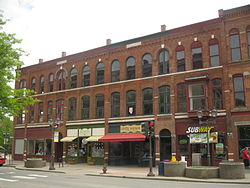
The Niagara Engine House is located on North Hamilton Street in downtown Poughkeepsie, New York, United States. It is a brick building constructed in the early 20th century, the only extant fire house of the six engine companies that once protected the city.

There are 75 properties listed on the National Register of Historic Places in Albany, New York, United States. Six are additionally designated as National Historic Landmarks (NHLs), the most of any city in the state after New York City. Another 14 are historic districts, for which 20 of the listings are also contributing properties. Two properties, both buildings, that had been listed in the past but have since been demolished have been delisted; one building that is also no longer extant remains listed.

Court Street Historic District is a national historic district located at Binghamton in Broome County, New York. The district includes 87 contributing buildings and encompasses the historic downtown core of downtown Binghamton. The majority of the contributing structures are commercial buildings built between about 1840 and 1939. Ten and twelve story office buildings built in the 20th century are prominent features of the district. Located within the boundaries of the district are the separately listed Broome County Courthouse and Binghamton City Hall.

Chapin Memorial Church is a historic Universalist church at 12 Ford Avenue in Oneonta, Otsego County, New York. It was built in 1894 and is a one and a half-story brick building on a tall, cut stone foundation. The facade consists of two parts: the main body of the church and the engaged three stage tower and entrance bay. It is characterized by an eclectic design that combines features characteristic of the Romanesque, Gothic Revival, and Queen Anne styles.

Old Post Office is a historic post office building located at Oneonta in Otsego County, New York, United States. It was built in 1915, and is one of a number of post offices in New York State designed by the Office of the Supervising Architect of the Treasury Department, Oscar Wenderoth. The original portion of the building is nearly square, seven bays on each side. It is built of Indiana limestone, with Concord granite trim in the Classical Revival style. It features a giant portico supported by six massive Corinthian order columns. In 1980, the building housed city offices moved from the Old City Hall.

Oneonta Armory is a historic National Guard armory building located at Oneonta in Otsego County, New York, built in 1905 with a brick and stone castle-like structure. It was designed by State architect George L. Heins. It consists of a two-story administration building with an attached drill shed. The building features a 5-story octagonal tower at the southwest corner and a 2+1⁄2-story square tower at the northwest corner.

Municipal Building, also known as Old City Hall, is a historic city hall building located at Oneonta in Otsego County, New York. It is three story masonry building with an ornate facade of painted brick and terra cotta, built in 1906 in the Beaux-Arts style. A central tetrastyle pavilion in the Ionic order dominates the upper floors. In 1978 a neocolonial clock tower was erected on the roof. It housed the municipal government until 1980, when they moved to the Old Post Office building.
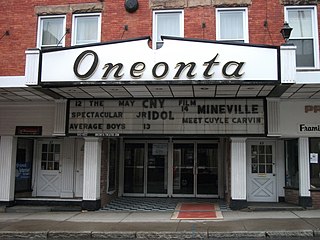
Oneonta Theatre is a historic theatre building located at Oneonta in Otsego County, New York. The original structure was built about 1897 and expanded in several stages. The original three story structure was a generally rectangular block with storefronts and theater entrance on the first floor and apartments above. A theater wing projected from the rear was set at a 45-degree angle. In 1922, the theater was expanded and the entrance relocated to the center of the building. The 1922 marquee was removed in the 1970s.

Bresee Hall is a historic institutional building located on the campus of Hartwick College at Oneonta in Otsego County, New York. It was designed by architect John Russell Pope and built in 1928. It is a rectangular, three story brick building with a symmetrical thirteen bay facade. The east facade features a projecting, pedimented three bay pavilion. The formal entrance is located at the center of the pavilion and consists of a portico composed of flanking pilasters and columns with composite capitals, a broad entablature and a segmental pediment. The building is topped by a hipped roof with a two-stage octagonal wooden cupola topped by a weather vane. The building has Colonial Revival style detailing.
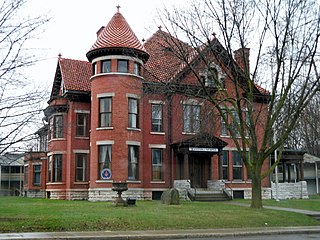
Fairchild Mansion is a historic home located at Oneonta in Otsego County, New York. It is a three-story brick building with a turret, gables, a pedimented entrance porch and a porte cochere in the Queen Anne style. The original house was built in 1867 and subsequently expanded and modernized in 1897 and 1915 by its owner, George W. Fairchild (1845-1924). The home was taken over by Oneonta Masonic Lodge in 1929.

Oneonta Downtown Historic District is a national historic district located at Oneonta in Otsego County, New York. It encompasses 64 contributing buildings and one contributing site. It encompasses the city's intact commercial and civic core and includes commercial buildings, six churches, the city's historic civil buildings, a few industrial buildings, and a small park. The district includes several separately listed buildings: the Masonic Temple, Old Post Office, Municipal Building, Ford Block, and Oneonta Theatre.

Christ Lutheran Church and Parsonage, originally the German Evangelical Lutheran Church of Ellenville, is a historic Lutheran church and parsonage located at Ellenville, Ulster County, New York. The church was built in 1862 in the Greek Revival style. It was moved, enlarged, reoriented, and completely remodeled in 1903–1904 in the Gothic Revival style when moved to its present location. It is a roughly L-shaped building, with a T-shaped main block consisting of a 1+1⁄2-story, gable-roofed front block and 1+1⁄2-story gable-roofed rear block. Appended to it is a 1-story addition. It features a two-tiered, square bell tower, central front entrance flanked by blind bays, and Gothic arched stained glass windows. The parsonage is a 2-story, three-bay-wide, Greek Revival–style brick dwelling built about 1850.

The Astral Apartments is an apartment building located at 184 Franklin Street in Greenpoint, Brooklyn, New York City. The Astral was built in 1885–1886 as affordable housing for employees of Charles Pratt's Astral Oil Works. It is a block-long brick and terra cotta building in the Queen Anne style. It features a central projecting section with a deep, three-story-high round arch recess. The roof features inward-looking decorative grotesques. Original amenities of the building included a settlement house, library, and kindergarten.
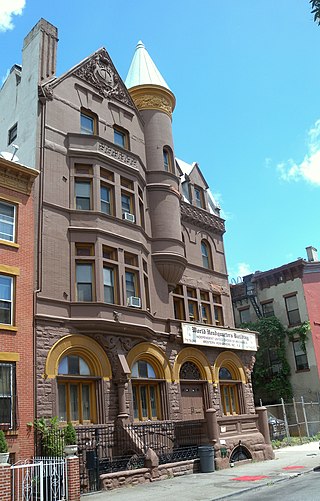
Lincoln Club, also known as Mechanics Temple, Independent Order of Mechanics of the Western Hemisphere, is a historic clubhouse in Clinton Hill, Brooklyn, New York, New York. It was built between 1886 and 1889 and is a 4+1⁄2-story Queen Anne style masonry building. It is built of Roman brick and rock-faced Lake Superior brownstone with smooth brownstone bands and terra cotta ornament. It has a sunken basement and the front facade features four distinctive arches on the first floor and a 2-story oriel window.
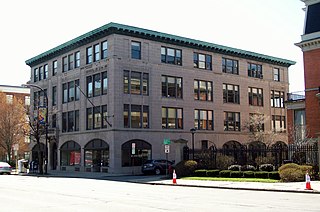
The Huyler Building is a historic commercial and office building located in downtown Buffalo in Erie County, New York. It was built in 1926, and is a four-story, four bay, reinforced concrete building faced in cast stone and brick in the Classical Revival-style. The front facade features three large segmental-arched display windows, balustraded balconet, and carved "Huyler's" logo with flanking griffons. Some of the interior commercial space at 376 Delaware was installed by Antonin Raymond (1888-1976) in 1939–1940. It was originally built for the Huyler's candy company and for over 80 years occupied by the locally prominent Pitt Petri store.
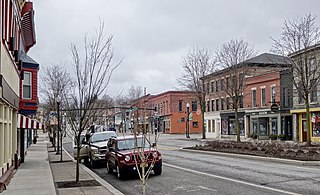
Perry Downtown Historic District is a national historic district located at Perry in Wyoming County, New York. The district encompasses 41 contributing buildings in the village of Perry. They are a variety of commercial, institutional, and governmental buildings with most built between 1850 and 1918. Most of the commercial buildings are two-stories and constructed of brick. They include the Town Hall (1909), Masonic Temple (1914), Bussey Block (1898), Bailey-Roche Block, A. Cole and Wygant Building (1867), Garrison Building (1901), Rufus Smith Block (1856), Howell Building (1895), Traver Place Apartments (1924), and the Wise Building (1903).
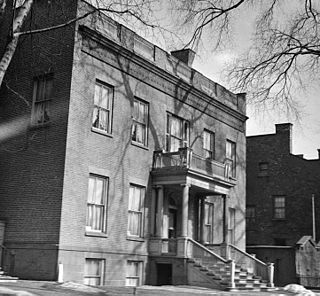
The Dr. Hun Houses were located on Washington Avenue on the western edge of central Albany, New York, United States. They were a pair of brick buildings constructed a century apart, the older one around 1830, in the Federal style. In 1972, three months after they were listed on the National Register of Historic Places, they were demolished and subsequently delisted.

Dick Block is a historic commercial building located at North Tonawanda in Niagara County, New York. It was built in 1891 and is a three-story, three bay, red brick building in the Romanesque Revival style. It features rounded windows and arches, rusticated stone detailing, and ornamental brickwork. The first floor storefronts were modernized about 1946, when the building was occupied by the Witkop and Holmes Company furniture store.
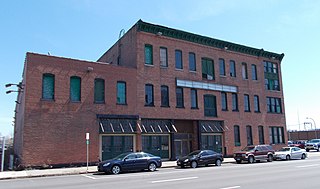
E.M. Hager & Sons Company Building is a historic planing mill located in downtown Buffalo, Erie County, New York. The main section was built in 1878 and is a three-story brick building. Two-story additions were made to the main block about 1880, and a three-story wing about 1920. It features brick corbelling and segmental arched openings. E.M. Hager & Sons Company remained in operation until the 1980s, after which the building was converted to a restaurant and night club.

Sinclair, Rooney & Co. Building, also known as the Remington Rand Building and Sperry-Rand Building, is a historic building located in downtown Buffalo, Erie County, New York. It was designed by the architecture firm Esenwein & Johnson and built between 1909 and 1911. The building is representative of Commercial Style architecture. The six-story, steel frame and concrete, "L"-shaped building is clad in yellow brick and consists of a rectangular main block, approximately 60-feet by 164-feet, with an extension of approximately 30-feet by 63-feet. It features brick pilasters that extend to the sixth floor, where they are capped by ornamental brick brackets and dentil molding below the roofline. It was built for Sinclair, Rooney, & Co., wholesale milliners, and later occupied by Remington Rand Corporation and its successor Sperry-Rand. The building housed offices and light manufacturing activities.
